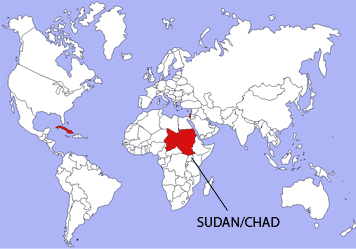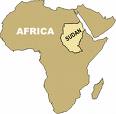
SUDAN
The genocide in Darfur resulted in the murder of 300,000 people and the displacement of 4 million more. This timely, global, and dramatic footage captures in-depth human stories completely unlike the typical “reporter in the field” views so often seen on the evening news.
Click HERE for 1.5 minute low-resolution video demo of Sudan footage.
 In 2008 Karin Muller spent three months living in Chadian villages, humanitarian aid bases, Sudanese and Chadian refugee camps, and traveling with the Chadian military while filming for Take 2. Karin learned Arabic and French and slept in tukuls, ate bool and drank local water, and made friends with villagers, refugees, rebels, soldiers, sultans, and aid workers - and survived two wars.
In 2008 Karin Muller spent three months living in Chadian villages, humanitarian aid bases, Sudanese and Chadian refugee camps, and traveling with the Chadian military while filming for Take 2. Karin learned Arabic and French and slept in tukuls, ate bool and drank local water, and made friends with villagers, refugees, rebels, soldiers, sultans, and aid workers - and survived two wars.
Karin captured stories of people like Gamar, the Sudanese butcher in the refugee camp - who doubled as the camp surgeon. He had no formal training, but pointed out that the inside of a goat isn't all that different from a man. And there was Fatima, the first wife of a village chief - 27 years old and already the mother of 7 children. She was proud of her culture and her religion, and traveled back to her burnt-out village with Karin to share her traditional life, little changed since the birth of Islam. Or Jeda, a 17-year-old girl in the refugee camp, captain of the volleyball team and a top student in her class, who wanted to become a doctor and had wholeheartedly embraced the modern world.
Karin returned with 37 hours of hi-definition footage, 18 interviews in 5 languages, and in-depth background notes on the people, the environment, history, and issues faced by refugees and military, aid workers and IDPs. This footage is available in two forms:
PROGRAMS
For High Schools and sophisticated Middle Schools: A choice of 6 modules, each containing 5 hours of footage with a specific theme: Women's Education in North Africa, Health Care, Humanitarian Aid, Displacement, and Surviving Genocide. Modules also come with a cutting-edge curriculum, translated interviews, comprehensive background information, and how to videos and documentation.
PRICE: One-year, single classroom educational license: $250. Special price: $95.
For College/Universities and sophisticated High Schools: A professional editing package with 37 hours of digitized and sequenced footage, translated interviews, 200 pages of tape summaries, flow charts, and background information.
PRICE: One-year, single classroom educational license: $995.
Life in the Camps....
“Why Girls Should be Allowed to Go to School”. It was a daring topic for a bunch of Muslim kids living in a Sudanese refugee camp. They had discussed the plot for weeks, though in the end most of them ad-libbed their lines. Their dressing room was a sagging UN tent and their stage a ragged mat on the wind-blown sand. To advertise they sent someone out with a megaphone to be their Pied Piper, and within half an hour they had hundreds of spectators. Nothing much happens in a refugee camp.
Their storyline was simple – a recalcitrant father refuses to allow his daughter to go to school, insisting that he needs her at home to cook his food, do his laundry, and haul his water. His wife, mother, male neighbor, and daughter all try to talk him into it, to no avail. Then one day his neighbor shows up, dressed in a suit. HIS daughter had gone to school, gotten a job, earned money, and is now taking him to Italy. The play closes on the regretful father, bemoaning his poverty-stricken future.
The audience was riveted by the neighbor’s transformation from rags to riches. I was fascinated by the argument that everyone used to try to convince the father to educate his daughter. “If you allow your daughter to go to school, then she will be useful to you.”
In other words, if she went to school then she could eventually get a job and give her father her entire salary, so he could retire and live in a big house. That’s because in poor societies without social security, children are often the only assets that a parent has. Their logic goes like this:
-- If you don’t have children, then when you can no longer work the fields yourself, you starve to death.
-- And if you choose to educate your daughters then they’ll just get married and give their salaries to their husbands – a pretty poor use of your limited family resources.
-- Further, the more you educate your daughters, the less marriageable they become since few men want to wed a woman who knows more than they do.
-- You need your daughters to marry so that they will bring in a bride price that you can then use to buy wives for your sons.
For a father who is trying to manage his human portfolio – his children – and make sure he doesn’t starve to death when he gets old, educating his daughters is not an obvious choice.
“She will be useful to you.” You could wrap an entire documentary around those six words.Want to read more stories from the field in Sudan/Chad?
How to make a grown man cry in a refugee camp.
The unexpected uses for a red-eared donkey in Chad.


